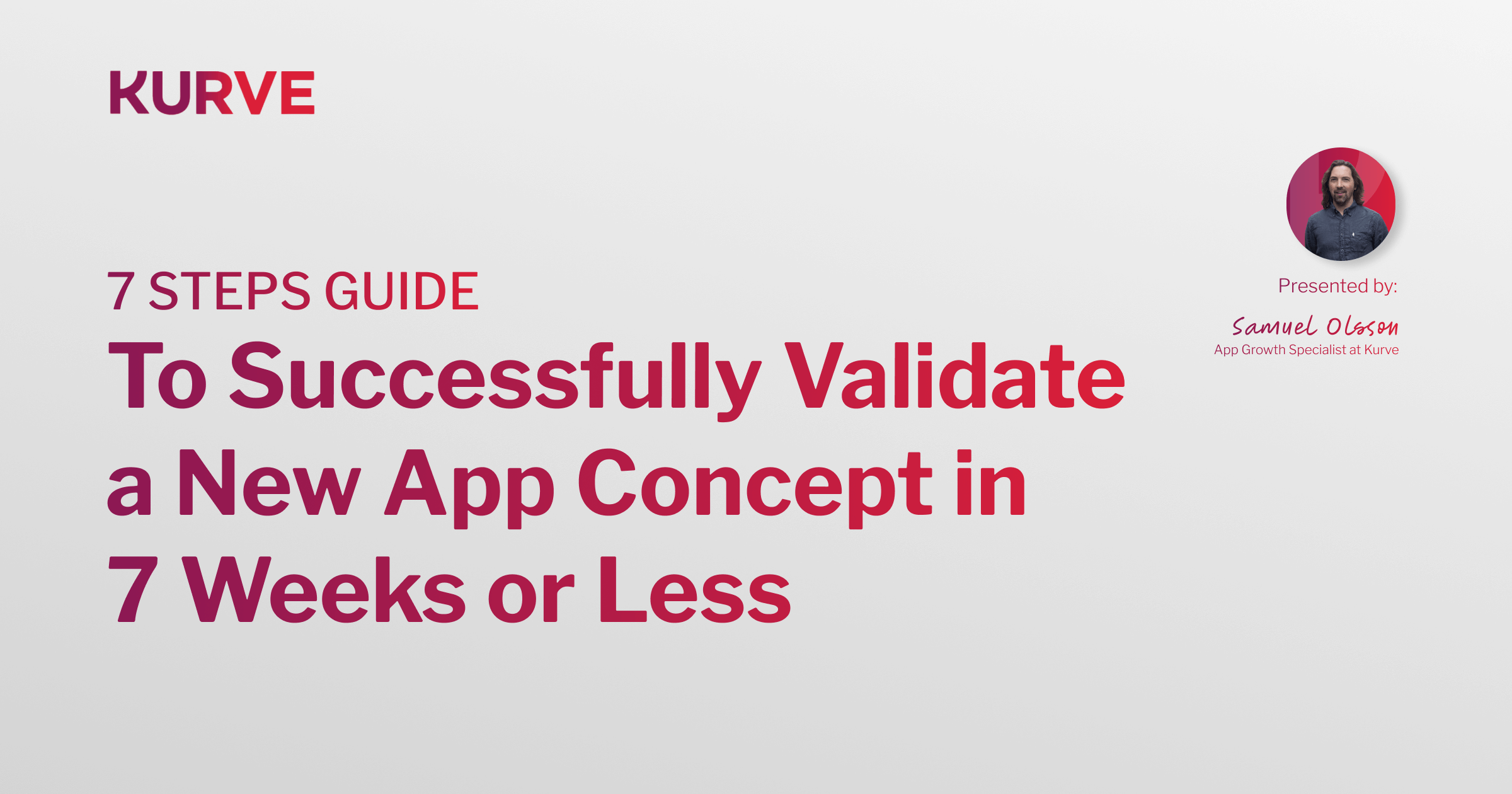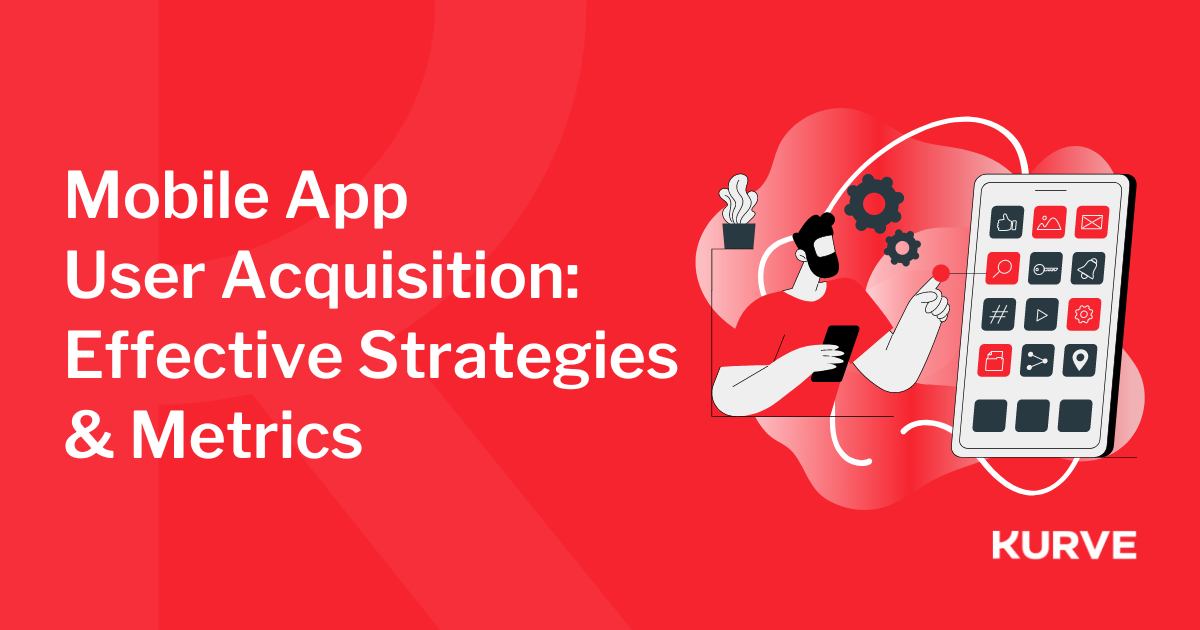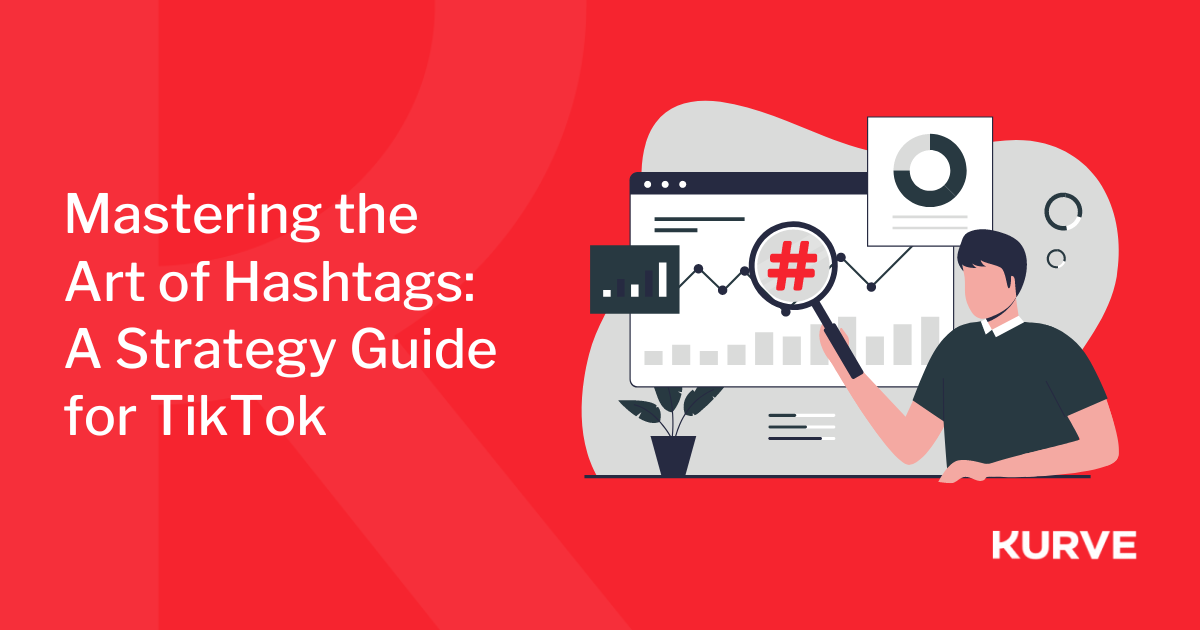Breaking the Mold: The SaaS Funnel Guide You Haven't Read Yet
Modern buying behavior has completely changed. With so many ways to buy and so many options to choose from, consumers ultimately end up choosing nothing or something that looks the most familiar.
As a result, the role of the marketing funnel has to adapt. Your objective in building a SaaS funnel is to help your buyers navigate this choice-dilemma and encourage them to choose your product. And there are many ways of getting people into your pipeline to nurture them.
The format of how you approach them changes according to the value of the client, the awareness of the problem that the software is solving, and the competition.
"Every article you're going to read about SaaS marketing funnels is wrong. It's all quite generic." – Oren Greenberg, Founder and CEO of Kurve.
As a marketing consultancy, we've developed SaaS marketing strategies for many successful SaaS businesses. In this guide, we'll share how to create a realistic SaaS funnel that captures the interest of a modern buyer.
Why Is This SaaS Funnel Guide Different?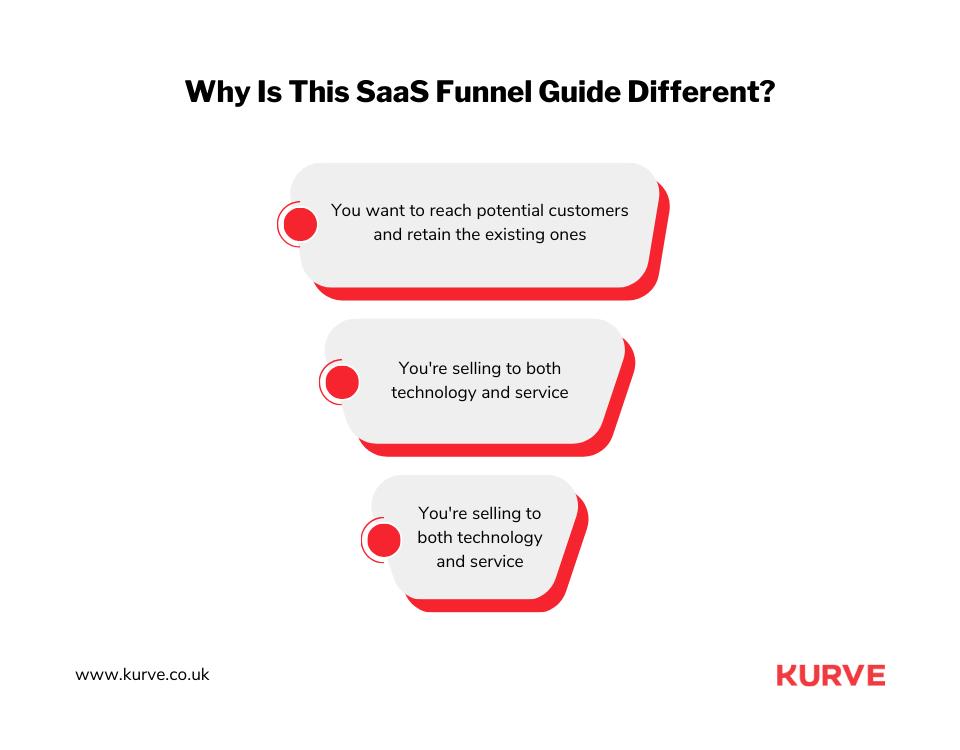
The marketing and sales funnel for SaaS companies are different from any other businesses.
Unlike the one-and-done-revenue model, SaaS companies rely on customer retention.
Marketing for SaaS is different from marketing in other industries in the most obvious ways;
- You're selling to both technology and service
- You're selling to both businesses and direct customers
- You want to reach potential customers and retain the existing ones
All other SaaS guides we see on the internet are going for a pirate funnel, AIDA Funnel, or an expanded SaaS funnel.
We have to understand that there is no one-size-fits-all SaaS funnel that will get you customers. There is no right or wrong. Different funnels serve different purposes, particularly the difference between B2B and B2C.
This guide will help you niche down your funnel approach with the power of personalization and advanced techniques to help you craft your own SaaS funnel for your product/service.
The Evolution of SaaS Funnel
A few years ago, creating new leads was the end goal of a SaaS marketing funnel. It was the last hurdle businesses needed to clear before selling.
The overdose of choices, user reviews, and the advent of self-guiding purchasing have moved lead generation to the top-of-the-funnel activity. The old SaaS marketing tactic was based on how you wanted to sell and not on the way your marketers bought.
There are some ugly truths about SaaS marketing tactics that we need to debunk:
- A download of your content or a webinar registration does not signal buying intent, especially for B2B buyers.
- You're wasting your marketing budget running ads on social media or sending bulk emails because people only buy from brands they trust and know. There are companies with better marketing presence and brand credibility.
- Publishing content focused on keywords and not quality. This approach is doomed because your chances of generating inbound leads are null.
SaaS buyers take a significant amount of time to decide, especially when ACV (Average Contract Value) is high. Businesses must also involve multiple stakeholders, evaluate options, and look for alternative solutions.
People don't shop in a linear way, and it's not right to think about the customer journey as a linear funnel. Lack of personalization in marketing can be brutal for your business when most buyers ignore non-personalized marketing efforts from vendors they haven't heard of.
While you cannot change the hard truth, you can redesign your marketing strategy to build a better SaaS-specific funnel.
And that's what we will learn to do in this blog.
Unraveling the Sales vs. Marketing Funnel Myth
"The problem is people are describing a marketing funnel, a sales funnel as one funnel. In actuality, it's multiple funnels." – Oren Greenberg, Founder and CEO of Kurve.
A complex buyer's journey means a lot of functional overlap of the sales and marketing team to bring a customer. Rarely does a deal come together as "click ad, fill out a form, talk to a salesperson, make a purchase." It's important to recognize the different sales and marketing roles in taking traffic from a given channel through to the stages to nurture them.
The Fundamental Differences
Marketing funnel: A marketing funnel gives an overview of the number of prospects on different customer journey stages. This insight helps predict how many sales-qualified leads your sales team can expect next quarter and even forecast a revenue quota.
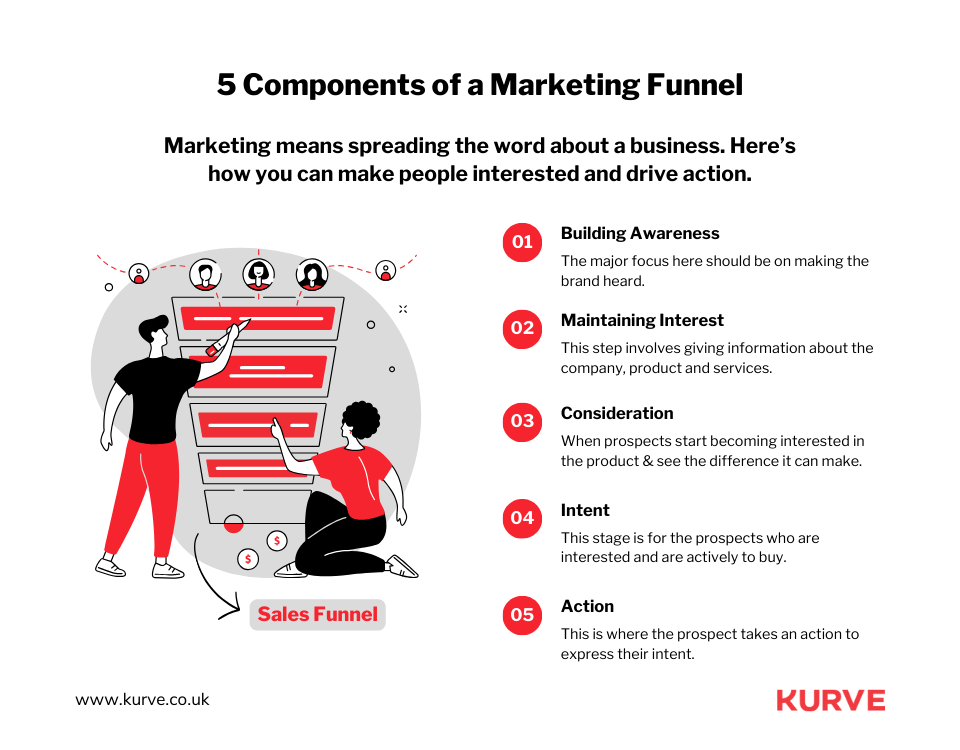
Sales funnel: A sales funnel is a visualization of your sales process and the steps it takes, from sales prospecting to closing deals. The core purpose of a sales funnel is to divide the sales process into micro stages and determine why you are losing leads.
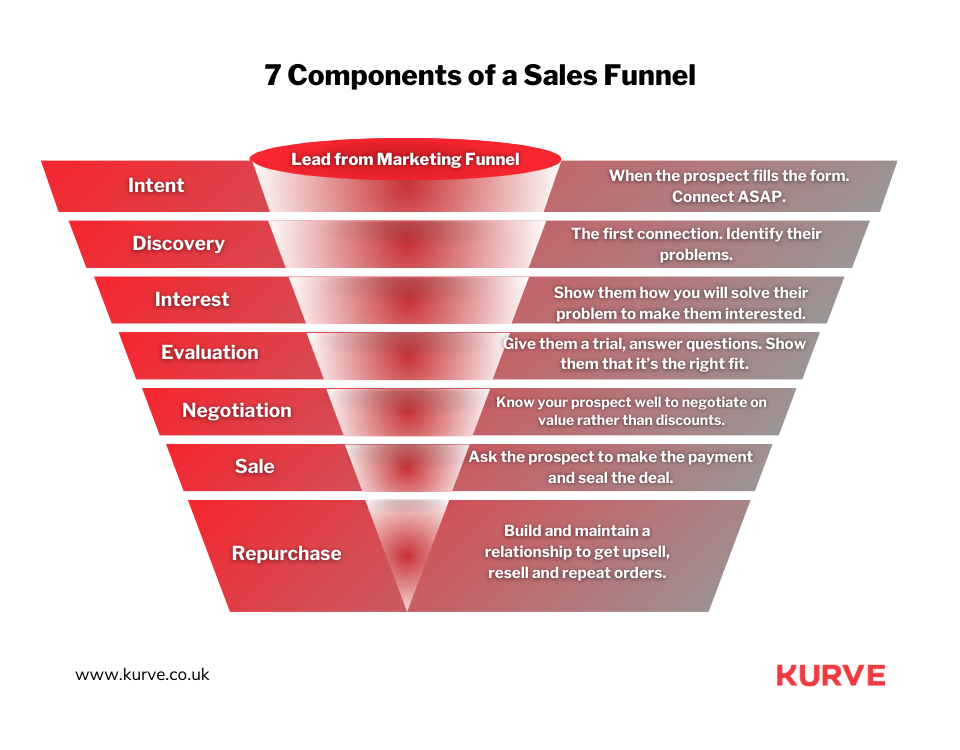
The Pitfalls of Combining the Two
Regular analysis of the sales and marketing funnel helps SaaS businesses shorten sales cycles, increase the close deal ratio and hit revenue quota more often.
While it sounds simple, many SaaS businesses make the dangerous mistake of mixing the two funnels. Here are some common pitfalls of combining marketing and sales funnel.
1. It combines lead generation and sales processes
By default, a marketing funnel means you need to reach the maximum number of prospects from your targeted market and generate leads. This strategy makes sense for small, simple SaaS businesses relying solely on local SEO and Adwords.
For B2B businesses with active buying committees, you need to warm up to nurture leads and set up lead scoring criteria on when a lead should be transferred to sales. Your sales team should only prospect and talk to leads that fit the ideal customer profile.
Otherwise, your sales and marketing team will be involved in an endless fight on who is responsible for low sales quota.
2. It focuses too much on sales-ready leads
Not every lead that comes in contact with your marketing campaign is sales-ready. Yet, most marketing teams make the mistake of making lead qualification as part of the sales team. This crucial filter sorts out all leads and protects your business from low-quality leads.
Your marketing funnel should perform these two qualification:
Marketing qualification
A lead can only be part of your pipeline when it passes the marketing qualification and becomes MQL (Marketing Qualified Lead). Marketing qualification means that the lead matches your ideal customer profile (belongs to your target industry or location), has specific buying traits and can afford your product or service.
Sales qualification
SaaS marketing teams use sales qualifications to transfer MQLs from the marketing funnel to sales. It means only passing those MQL leads that follow the pre-decided criteria between the marketing and sales teams.
This can mean that the leads;
- Visits your product or service pages
- Engages with nurturing content
- Downloads BOFU content
- Has a specific team size, tech stack, spending and revenue
- Has similar problems to your ideal buyer
Once the lead meets these criteria, they can be transferred from the marketing department to the sales funnel.
3. It doesn't show where exactly we missed the lead
If your sales and marketing funnel is 'reaching out to prospects> book calls> sending a proposal> won/lost,' you will never understand why you lost the deal.
Unfortunately, B2B SaaS has a complicated buying process and a long sales cycle. These four-step funnels would not work for them (even direct consumers no longer buy in this simple way). That's why you need to understand the full buyer journey and create separate funnels to understand where things went wrong.
Embracing the Reality of Multiple Funnels
There are three core funnels that every SaaS business needs;
- Marketing funnel
- Sales funnel
- Customer success funnel
We all talk about marketing and sales funnels but forget the most important funnel – the customer success funnel. Almost all revenue growth after a lead becomes a customer comes from customer success, which is not a marketing function.
Many SaaS businesses rarely track client success and have this "happy by default" mindset. A generic NPS survey isn't enough to determine if your customers are happy with your product or service.
You need a structured process that onboards customers, tracks their satisfaction, and discusses possible issues. Retention is a SaaS business's biggest goal and cannot go unheard.
Why should you have a separate SaaS funnel?
The multifaceted structures are designed to guide users through the various stages of the customer lifecycle, from awareness to conversion and retention. Here are four reasons why you should divide your funnels.
1. Accurate data
If you add up all the micro stages (discussed later in this guide) into a single funnel, it will become difficult to analyze its success. Another problem is that most businesses end with a sales funnel, so they have no idea how to track conversion in the customer success funnel.
Having multiple SaaS funnels helps businesses get answers to even the most basic questions that they don’t have an idea about;
- Do you know how many leads are in your lead nurturing program?
- How many in-depth customer interviews does your team do to understand expansion opportunities?
- At what micro-stage do you see a significant drop in lead capture?
SaaS business owners should know their business inside and out. Simplifying processes doesn’t mean you don’t go above and beyond to understand your customer’s needs and expectations with the product.
2. Different metrics
Revenue is the only metric that unites sales and marketing and the customer success funnel; all other measuring metrics are different. All of these funnels have different objectives and goals;
- A marketing funnel is meant to attract the right people
- A sales funnel is for converting that ideal customer
- Lastly, the customer success funnel is for retaining and expanding business opportunities
You cannot measure the effectiveness of these metrics through a general set of KPIs, which doesn’t give you a complete understanding of how the team is doing.
3. Preventing market and sales war
Marketing teams always have this mindset to generate more leads and fulfill their targets. But is that enough? NO!
Your sales team doesn’t need just one other caller. They want to speak to people who have problems your tool can solve. The goal of the marketing team should be to generate sales-qualified leads for the sales team.
Sales-qualified leads mean that the lead meets the criteria that both the sales and marketing teams agreed on. Otherwise, the war of blaming each other for low conversion is inevitable.
4. Funnel accountability
Every stage in the funnel needs monitoring.
Funnel accountability is crucial because it helps ensure that resources, efforts, and strategies align with organizational goals and objectives. Each micro stage in a funnel should have a dedicated person assigned who will report its progress, problems, and outcomes. Only then can you run successful SaaS campaigns in the long run.
How to Craft a Robust SaaS Funnel Strategy
The real reason why many B2B programs fail is because they rely on the assumption that buying is a linear process. It's not. The end goal of developing a marketing strategy is to build and implement a strategy based on how your best buyers buy.
A robust SaaS funnel strategy builds a clear path from point A (where you are now) to point B (where you want your business to reach in terms of revenue targets and business objectives) with required resources (people, tech stack).
"Even though people don't shop in a linear way, marketers try to harness the chaos through a sequential structure." – Oren Greenberg, Founder and CEO of Kurve.
By the end of this section, you will get answers to these 6 questions:
- Who are you going to market?
- How will you stand out and differentiate your product while resonating with your target audience?
- Where are these buyers present, and how do they buy?
- How will you attract their attention and make them interested in your product?
- What skill set and budget do you need?
- How do you measure the efficiency of your SAAS funnel strategy?
While these questions sound obvious, most SaaS businesses fail to answer them. Here is how you can craft an effective SaaS funnel strategy for modern buyers.
Step. 1 Identify and Understand Your Target Audience
It's a common saying in the business world that 80% of revenue comes from 20% of customers. Your Ideal Customer Profile (ICP) should be based on these clients.
An ICP contains a list of characteristics that your best customers have in common. By creating a set of criteria to look from, you can save valuable time that would otherwise be wasted on unqualified prospects.
Here is the step-by-step method for creating your ICP for B2B sales positioning.
1. Select a specific market segment
Dive into CRM and export your client information in Excel. Now, analyze revenue by verticals. You need to define the industries that bring the most revenue and select a segment you want to focus on.
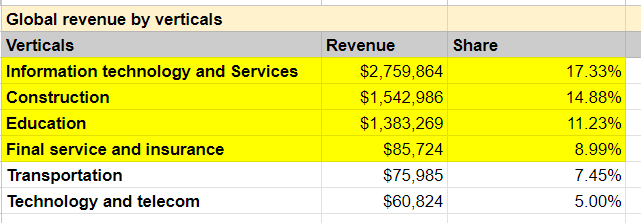
2. Segment review in the selected segment by clients
All clients aren't equal. Our focus is to find the clients that bring the most revenue.
Sort the list of clients of the selected segment from revenue high to low. Now, you can add 10% of those to Tier 1, the next 10% to Tier 2 and 80% to Tier 3.
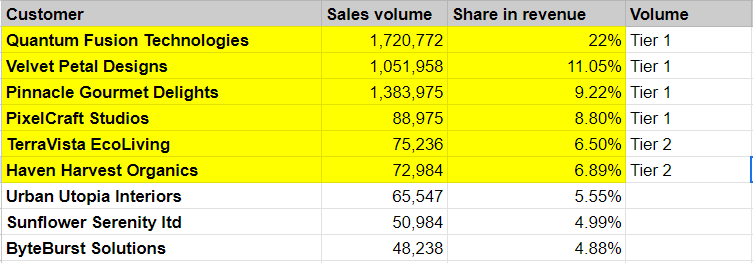
Define common firmographic patterns between these companies, including revenue, location, industry, team size, geo market, etc.
3. Select the best 10 customers to analyze their buying process.
Now is the time to understand why these people bought your product/service. Sit with your sales team and ask these questions:
- What goals do these customers try to achieve?
- What factors influenced their buying decisions?
- What concerns/objections did you face during the sales call?
- What were the benefits these people experienced after buying your product/service?
- What features/services did they mostly use or ask for?
You can also run in-depth customer reviews to understand their problems, objectives, and goals in detail.
At the end of this process, you will be able to get answers to your ideal customers:
- Buying triggers – What made them look for a product like yours?
- Research process – Where and how did they reach you?
- Decision-making process – What factors influence their buying decisions? Who is involved in the decision-making process?
- Expected value – The value they got from the product
- The goals, needs, and challenges of your target audience
- Where do they get industry information from? Who do they follow?
You can now paint a picture of who you are looking for, their buying habits, and where they are present. The more information you have, the better it is.
Step. 2 The Power of Personalization
Account-Based Marketing (ABM) is a marketing strategy that aligns your marketing and sales efforts by offering a customized buying experience for a set of identified buyer accounts.
"This is a far more effective strategic approach to coordinate sales and marketing on specific target accounts. ABM is born out of enterprise. So it's not applicable when thinking about lower annual contract value deals. So if you're a SaaS that's doing customers at like 50k a month, essentially anything that's under, say, 10k a year." – Oren Greenberg, Founder and CEO of Kurve.
If your business has the following characteristics, ABM is for you;
- Long sales cycle of more than 180 days
- Average Contract Value or ACV is more than $30k
- The target market is less than 1000 companies
- Multiple decision-makers involved in the buying process
So, how do you implement Account-Based Marketing? Here’s our three-step process.
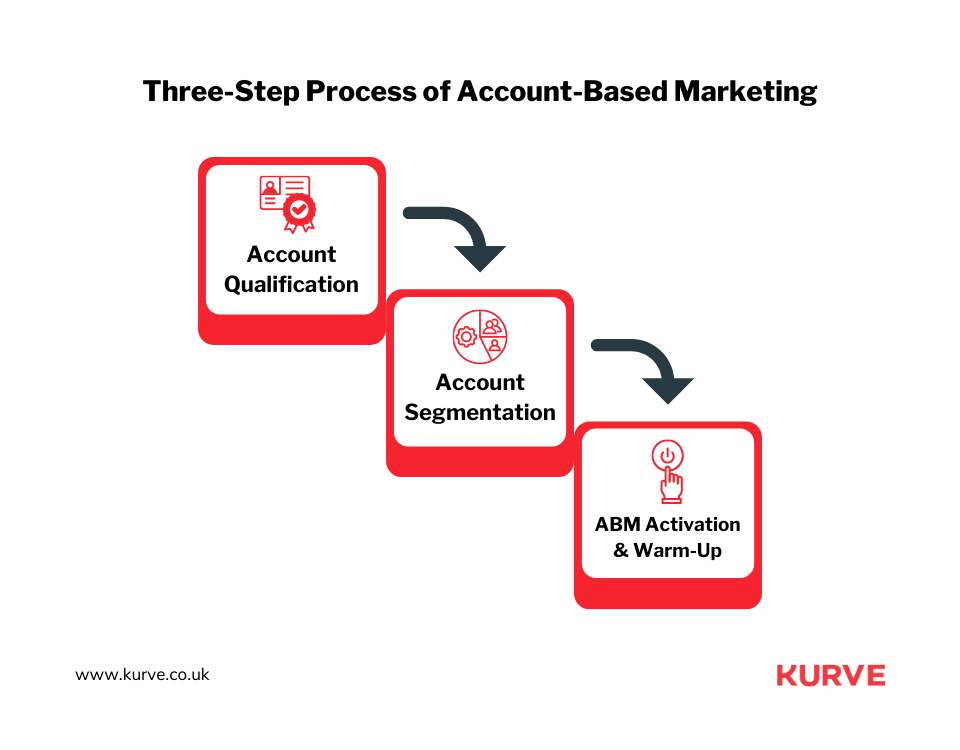
1. Account qualification
When we create the ICP, we segment the clients into tiers 1, 2, and 3, tier 1 being our top clients and tier 3 contributing less revenue than tiers 1 and 2.
When you research these tiers, you will find certain common characteristics. Now, for each of the tiers, you need to have a clear answer about;
- What makes an account a good fit for this tier? For example, a high ACV, actively hiring, has only 3-4 decision-makers.
- What makes this account a bad fit for this tier? For example, there are massive layoffs, no funding in 12 months, and too many decision-makers.
You don't need a lot of accounts for your ABM. You need fewer accounts that will certainly buy your product.
2. Account segmentation
If a specific account can generate 20x more revenue than an average customer, why market them the same way? In ABM, we run marketing campaigns based on three tiers inside your ICP.
|
Tier 1 |
Clients with the highest ACV or generate more than 10-15% of your revenue should get personalized 1:1 campaigns. |
|
Tier 2 |
Clients with medium ACV or generate 4-10% of your annual revenue should receive one to few marketing campaigns. |
|
Tier 3 |
Clients with the lowest revenue don’t need to run manual campaigns to land deals with them. Tier 3 accounts usually come from your demand generation and demand-capturing activities. |
3. ABM activation and warm-up
Now, start identifying companies that best suit your ICP. You can do it by;
- Tracking your website activities by tools like Leadfeeder or Clearbit
- Analyzing demand gen programs like webinars, events, newsletters, podcasts and thought-leadership.
- Looking for connections in your network
- Joining communities and associations where your target buyers reside
Once you have the accounts for each tier, you can develop personalized solutions for every buyer. Talk about their challenges and how the product helps, and show them some proof. You can create a multi-channel warm-up and activation program to distribute these personalized solutions, including;
- Personalized ads
- Content hubs
- Content collaboration
- Social engagement and selling
- Direct mail swags
- Micro-events, etc.
"80 percent of the growth comes from that one channel. Some became popular through a book, podcast, SEO, paid search, organic social, or paid social." – Oren Greenberg, Founder and CEO of Kurve.
ABM is definitely a time-consuming process, but the personalized approach makes this the best way to reach high-end clients.
Step 3. The Role of Testing and Continuous Learning
A good marketing campaign can help you achieve four typical goals;
- New revenue
- Expansion
- Deal acceleration
- Renewal/ churn prevention
The reporting for each of these goals is different. Here is how you can measure these goals.
New revenue
Campaign goal: generate new opportunities and revenue
Core metrics:
- Number of discovery calls booked
- Number of engaged accounts
- Sales cycle length
- ACV
- Won deals
- Budget
- New revenue
Expansion
Campaign goal: Expand businesses with existing clients
Core metrics:
- Number of case studies created
- Number of licenses sold
- Number of workshops arranged
- ACV growth
- LTV growth
- Total expanded revenue
Deal acceleration
Campaign goal: Winning new opportunities
Core metrics:
- Number of interviews with champion
- Number of debriefing sessions
- Number of workshops booked
- ACV
- Won deals
- Campaign revenue
Contract renewal / Churn prevention
Campaign goal: renew contracts with key accounts
Core metrics:
- Number of presentations booked
- Number of resigned contracts
- Renewed revenue
After you measure these core metrics, you will realize areas that need improvement. No marketing campaign is perfect at the very first go. You have to test its effectiveness and make necessary changes to reach its maximum potential. Conduct A/B testing for promotional channels, targeted accounts, ads and offers. Keep 10-20% of your marketing budget for testing so you can change your strategies without losing a lot of money.
Optimize Your Existing SaaS Funnel Strategy
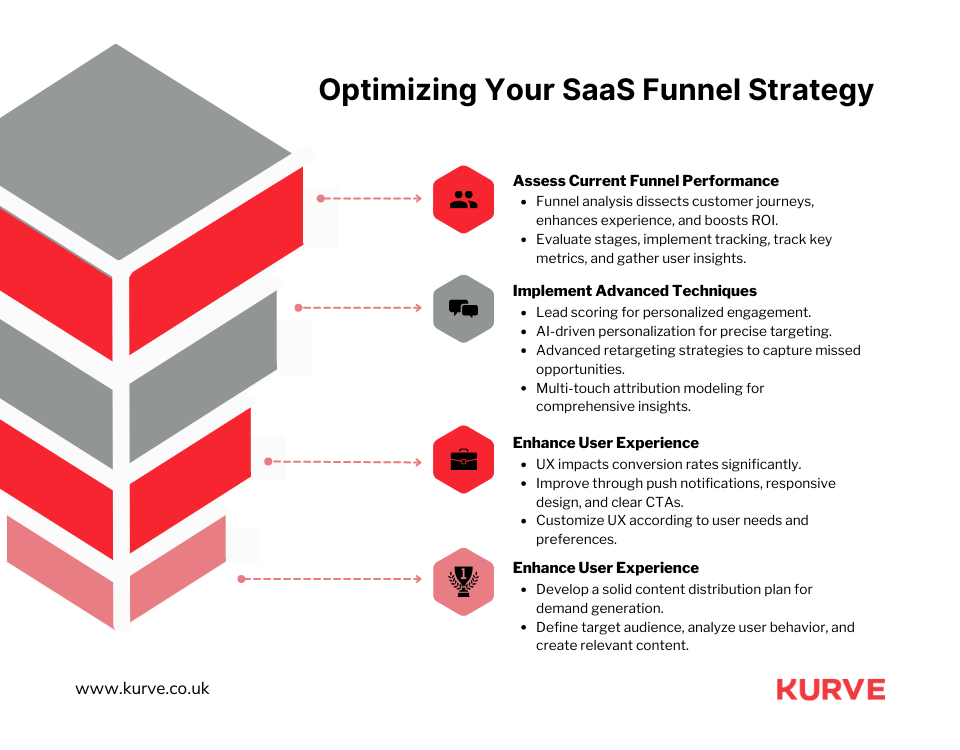
Change is the only constant in SaaS. The ever-shifting currents of the industry, rapidly evolving technological advancements, changing customer preferences and market trends emphasize the need to refine your SaaS funnel strategies. Optimizing your sales funnel is as important as creating one.
Here is how you can do it.
1. Assess Your Current Funnel Performance
Funnel analysis is a dedicated approach SaaS businesses use to dissect and optimize customer journeys through various stages and identify where they are dropping off. This method would help you enhance customer experience, identify and resolve customer pain points and optimize your funnel to improve your SaaS funnel ROI.
Here is a checklist for evaluating the strengths and weaknesses of existing funnels;
- Break your funnels of sales, marketing and customer success into various actionable stages
- Implement tracking codes, often called pixels, to help you visualize how a user interacts with your website
- Track key metrics like conversion rate at each stage, bounce rate, exit rate, average session duration and click-through rate. Compare the numbers with industry benchmarks to understand where things are going wrong
- Talk to users to gain insights into their problems, areas of improvement, and future suggestions on how you take a user from point A to point B
- Interpret your funnel analysis result and make the required changes. For instance, if your pricing page has the highest bounce rate and users also say that they find it confusing, it's time to revamp that section of your website and repeat these steps
As we discussed, not all users are the same; therefore, your funnels can't all be the same. Each SaaS funnel should be analyzed according to the user segment, buying trends and engagement. Evaluating your SaaS funnels on these parameters is critical for your growth strategy.
2. Implement Advanced Techniques
The rapid development of new technologies introduces innovative ways to engage and convert leads. From AI-powered chatbots to personalized user experiences, keeping abreast of emerging technologies ensures businesses can leverage these tools to enhance their funnel performance.
Here are some of the latest cutting-edge strategies to optimize your SAAS funnel;
- Lead scoring – Every customer is different, so do they require the same effort? To identify your best customers, you can implement lead scoring. Each of your leads will have a score based on predefined criteria on the likelihood of making a purchase. You can either do it manually or use tools like Active Campaign to automate the process.
- AI-driven personalization – Account-based marketing requires precise targeting and personalized messaging for key users. Doing this is not possible manually. AI-driven marketing helps you automate those tasks and optimize marketing efforts. You can use AI for emails, recommendations, human-like interactions and more.
- Advanced retargeting strategies – The majority of users that come to your site will not convert the first time. That's why retargeting strategies are a critical part of any SaaS business. You apply the following strategies in your retargeting campaigns;
- Targeting people who click on your PPC ads
- Using different ads for different pages
- Segmenting users by intent and running different retargeting campaigns
- Target people who engage with your social media
- Retargate existing users
- Retarget users that spend the most time on your website
- Multi-touch attribution modeling – A buyer's journey goes through many devices and touchpoints before resulting in conversion. Multi-touch marketing is a method that measures all the touchpoints of the customer journey and designates a certain amount of credit to each channel so that marketers can evaluate the value of each touchpoint.
3. Enhance User Experience
Your website is the path visitors follow to become customers. A key factor differentiating your product from others is good User Experience (UX). UX impacts whether the user will return to the site and make a purchase.
Improving UX designs can help enable a business to achieve a conversion rate as high as 400%, and this is how you can do it;
- You can send push notifications to your most active users using tools like Mixpanel and conduct user surveys and feedback sessions to understand pain points
- Implementing responsive design for a seamless experience across devices
- Make a good first impression by directing new users on what to do next to get onboarded
- Customers expect your website to be lightning-fast, or they will turn to your competitor Regularly analyze your website on loading speed and make suitable adjustments to improve its loading time
- Incorporating intuitive navigation and clear call-to-action buttons for users to take quick actions
Good UX is not a one-size-fits-all solution. It needs to be optimized according to the specific needs of the users. This means focusing on things like branding, navigation, and how they troubleshoot a problem so they can account for any type of interaction that happens on your website.
4. Refine Content Distribution Strategy
A refined content distribution plan is important for demand generation and product awareness. You can't sporadically promote published content via ads or share it on social media.
So, unless you are a well-known brand constantly producing top-notch content your audience is waiting for, you need a solid content distribution strategy.
Here is how you can launch an effective SaaS content strategy from scratch;
- Determine a clear ICP, market positioning and content goals to clearly define who you are targeting
- Run customer interviews and analyze user behavior to understand their problems, topics they find interesting, communities/associations they must engage in and channels they use for education and research
- Now characterize topics into these four buckets;
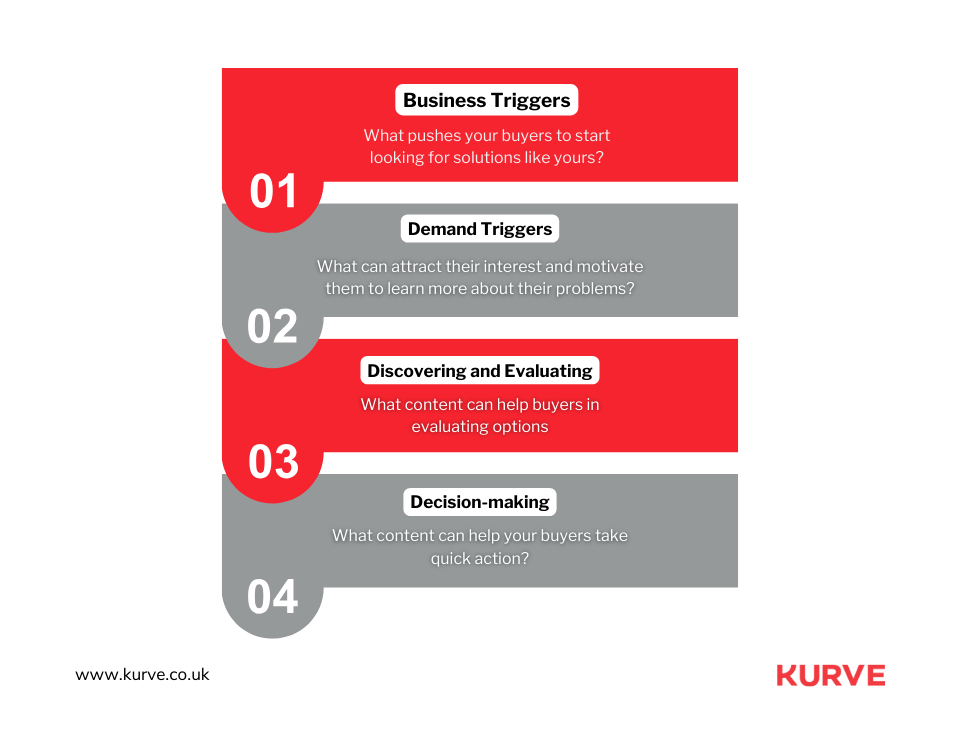
-
- Business triggers – what pushes your buyers to start looking for solutions like yours?
- Demand triggers – what can attract their interest and motivate them to learn more about their problems?
- Discovering and evaluating – what content can help buyers in evaluating options
- Decision-making – what content can help your buyers take quick action?
- Conduct a content audit to find gaps in existing published content
- Tailoring content to different stages of the funnel (awareness, consideration, decision)
- Improving content quality should be your utmost priority. B2B buyers smell bad content from a mile away and run away from it
- Distribute your content wisely through these platforms;
- Linkedin blogs
- Monthly webinars
- Guest posts on reputed websites
- Content distribution through the sales team
- Leveraging dedicated communities according to your product
- Grow your audience through email newsletters, Whatsapp/telegram channels or your community
Ranking on the first page for a keyword shouldn't be your priority. Instead, SaaS leaders should focus on getting qualified, high-converting traffic that generates paid users. Align your content with the brand story to lead an ever-lasting impact on your readers.
5. Continuous Monitoring and Iteration
Establishing a consistent feedback loop reduces churn and improves customer relationships over the long run. It allows you to stay up-to-date with the latest buying trends and customer preferences and gives you the liberty to make changes.
You can do the following to set up a regular SaaS funnel review;
- Schedule monthly or quarterly funnel reviews to identify areas of improvement
- Leverage feedback from the sales and customer support team to understand overall customer satisfaction
- You can adopt dedicated tools to monitor your users' interaction with your website
Customer feedback also has a significant influence on Saas's funnel strategy. It shows how your customers want to see your product vs how you see it. You can conduct customer satisfaction surveys, ask for product reviews, and monitor Net Promoter Score (NPS) to learn how your business is doing and what needs improvement.
The Road Ahead for SaaS Marketers
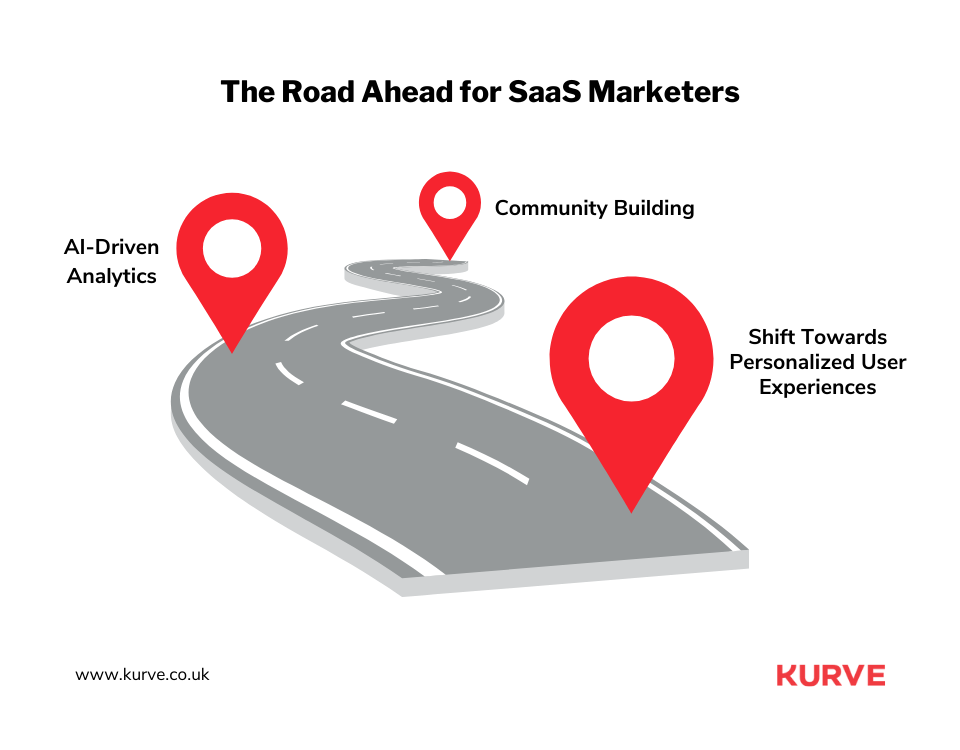
The SaaS marketing landscape is continually evolving, driven by technological advancements, changing consumer behaviors, and industry innovations. Several trends are shaping the future of SaaS marketing and how we approach potential customers. Some of these trends are;
- AI-Driven Analytics: The integration of artificial intelligence and machine learning in SaaS marketing is leading to more sophisticated predictive analytics. AI algorithms can analyze vast datasets to predict user behavior, customer preferences, and potential churn. This enables SaaS companies to address issues and optimize their marketing strategies proactively.
- Community Building: Online forums, social media groups, and other community platforms provide spaces for users to share experiences, ask questions, and connect. SaaS companies can leverage these communities for customer support, feedback collection, and brand advocacy.
- Shift Towards Personalized User Experiences: SaaS marketing is moving towards hyper-personalization, where every interaction is tailored to the individual user. This includes personalized onboarding experiences, targeted content recommendations, and customized user interfaces. Machine learning algorithms are key in understanding user preferences and delivering these personalized experiences.
As the industry continues to evolve, staying abreast of these trends will be crucial for SaaS companies aiming to remain competitive and effectively meet the evolving needs of their users.
Ready to elevate your SaaS funnel strategy? Partner with Kurve and navigate the future of SaaS marketing with confidence.
